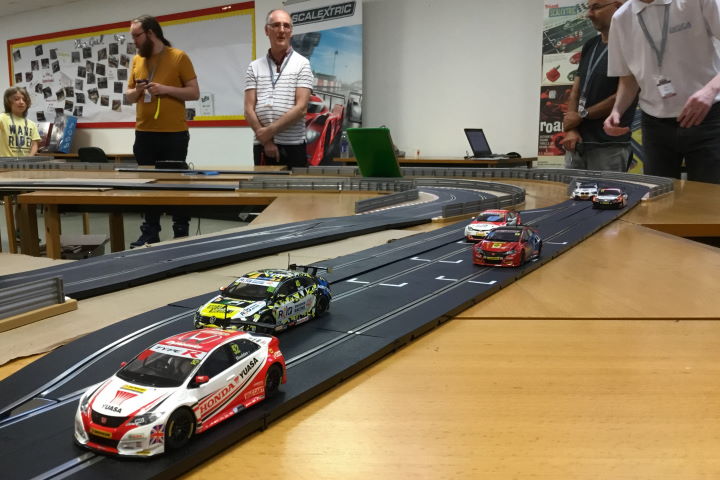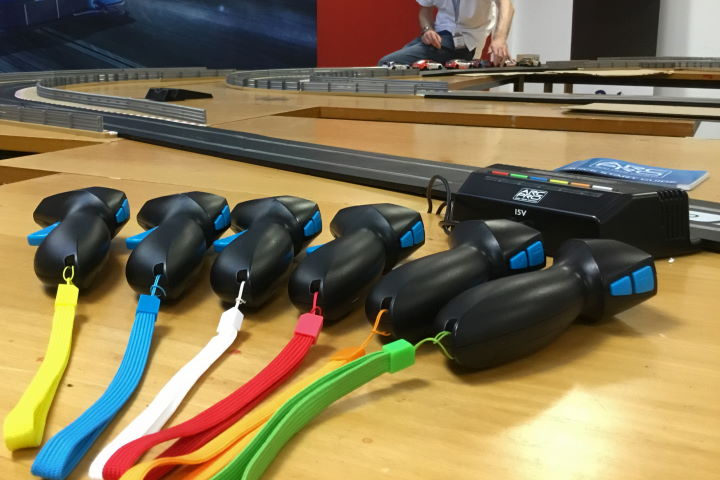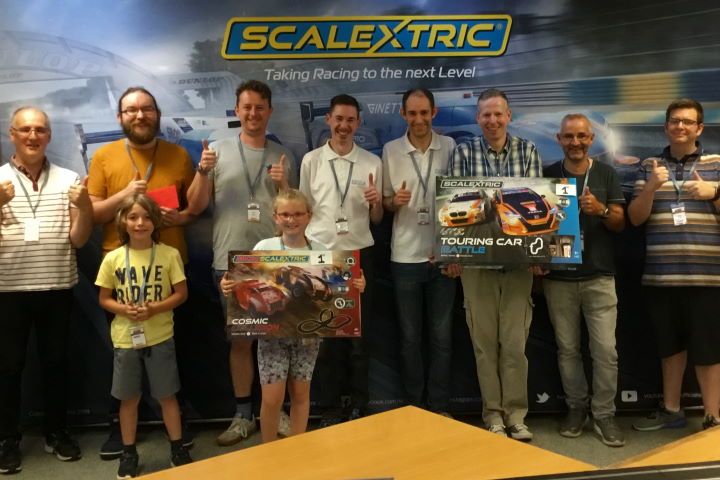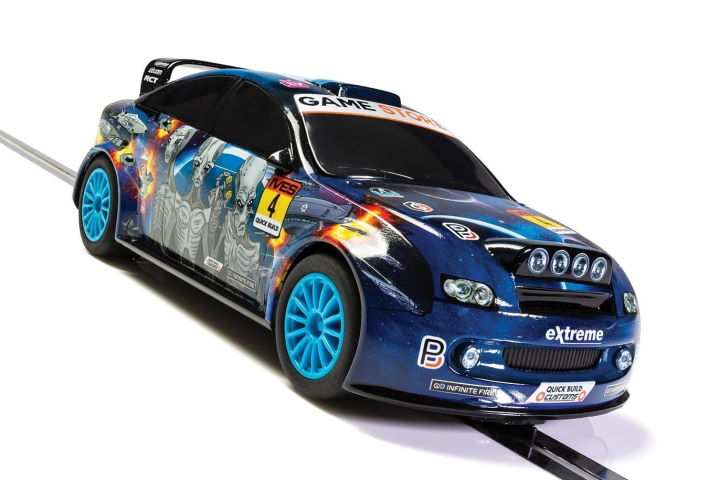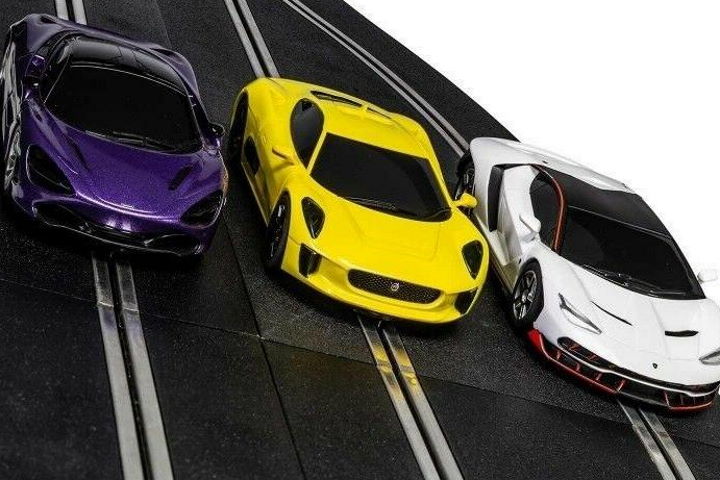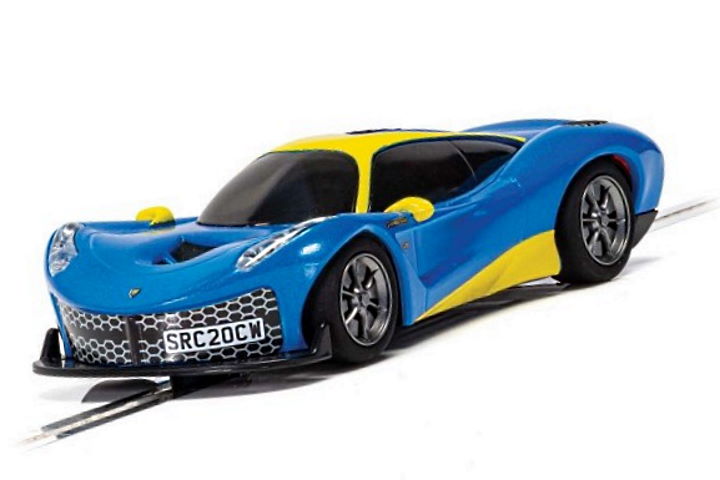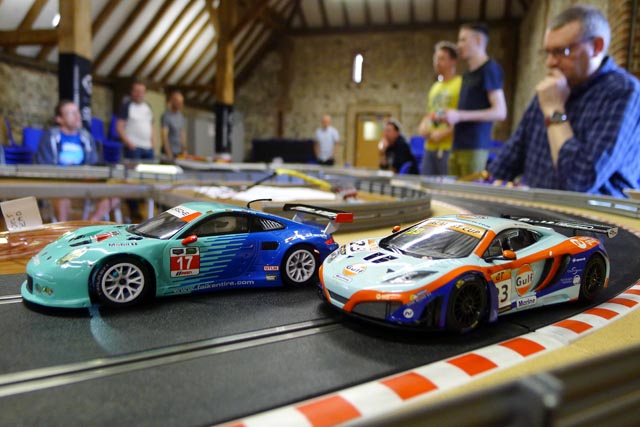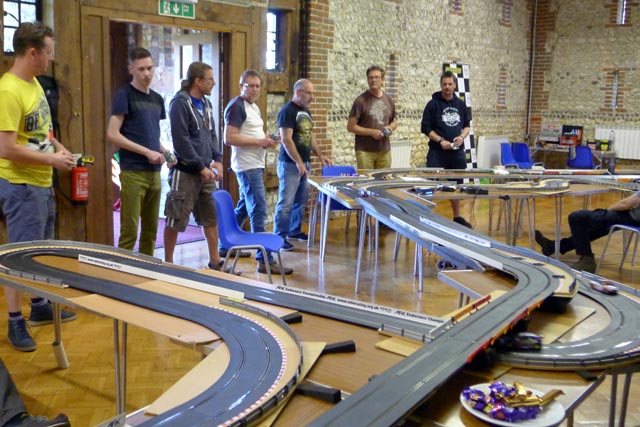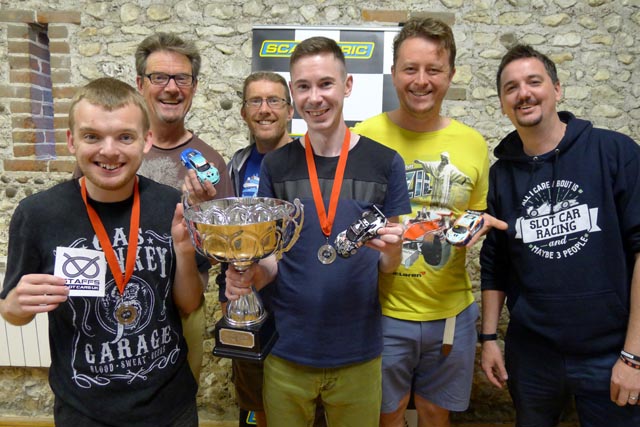With up to six cars racing on two lanes, digital slot car racing has the potential for carnage.
It doesn’t have to be that way. Some good coaching of new racers and an aim of ‘no-contact racing’ can increase the realism – giving hours of exciting and enjoyable action.
No-Contact Racing
This is a term coined by Adrian Norman, a member of the Scalextric team who championed the development of digital racing in the 2000s. This is what Adrian wrote:
For any newcomer to digital racing, their first experience is that everyone crashes into each other because the cars share the same lane. Amusing for the first few minutes! This is when drivers who want a fairer race, and less of a destruction derby, might be put off from racing with digital. There is a simple fix.
The appeal of digital racing is to be able to change lanes, use the pit lane, select better racing lines, pass slower cars by changing lane at the right time. So, to add these factors into the race and to avoid single-lane multiple-car crashes, one rule has to be applied rigidly and without mercy: NO CONTACT.
Exactly how you apply this aim is up to you. However, if Scalextric digital is about making slot car racing as close to real racing as possible, then contact should be minimised and penalties should be handed out when racers overstep the mark. That’s what happens at race tracks around the world every weekend, with some series much stricter than others.
The interpretation below has been developed for Scalextric digital home racing and for club racing at WHO/digital in West Sussex.
Digital Driving School
Everyone is a first-time digital racer at some point. It can be an overwhelming experience – so much to remember and to do! Time coaching digital ‘newbies’ at the start of a racing session is time well spent. Gentle encouragement and a gradual introduction to the various aspects of digital racing helps the process along.
Start with the basics – explain how to use the controller and how to accelerate on the straights and slow in the corners. Do some laps until the new digital racer is keeping the car on the track and having fun. Then introduce the lane change button and practice some lane changing – including a few trips through the pits. As more drivers join in, this is a good time to introduce digital race craft – plan ahead, look ahead, look behind – and the principle and practicalities of ‘no-contact racing’.
The next big step is to look at the software – the Scalextric ARC app or Magic app. Take it gently, walk through the pit stop process – and practice, practice, practice! Then – and only then – is the newbie ready to race. And that is the start of the next learning curve.
Driving School Cars
It is wise to have some robust – and perhaps a bit bashed-up – cars for the first steps. Not having to drive the latest high-detail beauties helps reduce the anxiety for the new driver and the car owner. If you are introducing lots of new racers to Scalextric digital, these driving school cars can also double-up as race cars to begin with.
Although they need the C7005 retro-fit chip soldered in, a set of four or six of the Super-Resistant START, Team GT, Team Rally and Team LMP cars make ideal driving school and beginners’ race cars. They do soak up a lot of punishment and are easy to drive. A good Digital Plug Ready (DPR) alternative would be any of the Hypercars, especially the new Scalextric Rasio C20.
What is ‘Contact’?
This is pretty much any time two cars collide and you hear that ‘crack’ of plastic hitting plastic. More specifically:
- A car pushing the car in front into a corner to make it de-slot
- A car ‘brake-testing’ the car behind, whether a de-slot is caused or not
- A car pushing a de-slotted car out of the way
- A car changing lanes into another car
- A car exiting the pit lane into another car
These incidents may be deliberate or accidental actions, but they are all ‘contact’.
Penalties for Contact
The original aim of non-contact racing was to punish all contact with a drive-through or stop-go penalty. The degree of punishment is up to you to decide in advance and for a nominated ‘Race Controller’ to implement at the race. In the West Sussex formats, this is what we do:
- Any contact incident must be apologised for immediately.
- A second offence is an official warning.
- A third offence is a 5-second stop-go penalty.
- Repeat offences – or repeated refusal to apologise – means disqualification in an individual race or immediate replacement by a team mate in a team race.
- Stopping on track outside of the pit lane to make a pit stop – instant disqualification.
The aim of these penalties is to minimise contact, but also to encourage friendly conduct and to dampen down frayed tempers. Too rigid and draconian penalties can sour the atmosphere – as can too lenient application of no-contact racing rules. It is all about getting a balance to ensure a specific group of people enjoy the racing as much as possible – and the cars stay in one piece!
Marshalling Crashed Cars
When cars crash, they need to be replaced on the track. If you have more racers than cars, then those not racing can replace cars in full-speed race conditions. They are the ‘corner marshals’ of the slot car track. Following the no-contact ethos, it is important the marshal replaces the car carefully, away from any on-coming cars. It is better to be slow and safe, than rushed and sorry. That’s the big lesson for Digital Marshals’ School!
It is equally important that marshals are allowed to do their job in peace. However tempting it is to yell at a marshal to hurry up, such behaviour is frowned upon in the West Sussex racing – and can lead to penalties as described above. Racing is all about fun, not being shouted at… And if you crash and lose time, it’s your fault for crashing. The lesson is – drive more carefully and don’t crash.
If everybody is racing and no-one is marshalling, there is the option to replace your own car in race conditions – something fraught with non-contact penalty implications – although possible with the ARC Pro wireless controllers. The other option is to use the ‘Yellow Flag’ or ‘Pause’ features in the ARC app. Yellow Flag reduces each car’s speed to its calibration level. Pause simply stops all the cars and pauses the race. Yellow Flag and Pause work better with experienced drivers who may crash no more than every 5-10 laps. For a group of novices crashing every lap, it is likely to be very frustrating. It may be worth standing two drivers down, to have four racing and two marshalling.
Having Fun!
Whether you are racing with family, friends or have formed a digital slot car club in a public space, using ARC Pro should always be about maximising the fun factor for everyone – including you. Finding the right balance between penalising contact and keeping the racing flowing will depend on many things and can be a difficult juggling act. If you are getting upset by your cars getting damaged, think about ways to work around that – cheaper, more robust cars; reducing the power settings; running without magnets; or insisting racers bring and race their own cars. There is always a solution!


